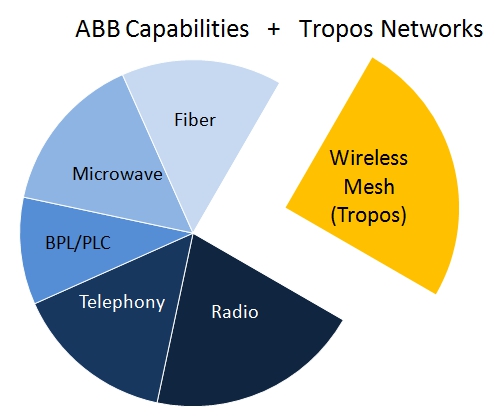The brief ABB announcement of June 1, coupled with Tropos Networks CEO’s note to friends of the company on June 4, highlight this new acquisition achievement on the part of ABB’s strategic planning groups based in Switzerland (and Germany, and Sweden, and the U.S.A.).
Some readers may not be aware that ABB is a key global player in the utility telecommunications field, winning contracts annually worth hundreds of millions of dollars with its own extensive communications equipment offerings, and supplemented by one of the world’s largest telecommunications network design and development service organizations.
Internationally, many countries outsource the design and development/upgrading of telecommunications networks across the energy spectrum. This is especially true for the developing regions of the world. Key participants in this billion dollar-plus marketplace include the global control systems companies such as Siemens and Alstom Grid, along with ABB. Other key participants in energy telecommunications network development include Alcatel, DIMA, RFL, Selta and Telvent.
Let’s take a closer look at this key ABB acquisition. First, keep in mind that one of the few “gaps” remaining in ABB’s rather pervasive communications offerings is wireless mesh technology. This gap is found in the wireless mesh portion of Tier Two network requirements, and may well extend to “Tier Three” level of utility/energy telecommunications – the field area networks required for distribution automation (not to the NAN or to the meter). ABB has a long and successful history of providing telecommunications systems for Tier One (backbone network infrastructure) and much of Tier Two (backhaul) networks for utilities and energy companies around the world, mainly outside of North America. This opens many doors to ABB clients who have worked with the company in the development of the first two tiers, and who are preparing for additions to Tier Two and work on Tier Three network development. See the chart below.

(c) 2012 by Newton-Evans Research Company
ABB is a highly regarded telecommunications equipment manufacturer (or OEM buyer) in just about every other communications technology area that impacts energy and manufacturing industries, including multiplexing, teleprotection, local area network switches, power line carrier equipment, microwave systems and voice communications. Its wide ranging “Fox-family” product offerings have played a key role in its success in energy telecommunications. ABB engineering skillsets and capabilities can be found in radio, microwave, telephony, fiber (SONET and SDH), BPL and PLC technologies.
Tropos Networks, a 12 year-old privately-held Silicon Valley firm, has grown from start-up status to leader, and an international market participant, in the growing market for wireless mesh technology to support smart grid initiatives, (especially for advanced metering infrastructure, and to some extent for distribution automation) and has a leading position in the provision of municipal/metro area broadband services. The company has shipped some 60,000 routers to more than 850 customers in 50+ countries to date.
However, reading between the lines of this important acquisition, in addition to gaining wireless mesh products, the synergistic benefits accruing to ABB also include the small but strong engineering and support services staff of Tropos Networks, which now will be able to tackle assignments yet to be won by ABB that are further afield from its North American roots. This service capability supplements the company’s highly touted line of wireless mesh equipment. Tropos Networks products and services will also gain a market position in the gas/oil pipeline business and in certain industrial and mining applications where wireless mesh technology can be used as an adjunct with other specialized ABB-developed communications approaches. Freshen up those passports, Tropos staff!
The recent Newton-Evans publication “Global Study of Data Communications Usage Patterns and Plans in the Electric Power Industry: 2011-2015” may be a valuable resource in your company’s plans for the upcoming re-development of grid telecommunications infrastructure. Interested readers can download a brochure and excerpts from this report series on our “reports” tab at www.newton-evans.com .

 summary reviews and highlights from completed studies
summary reviews and highlights from completed studies
